Pakistan nuclear missile arsenal. When you have only one opponent
Of course, either of the two superpowers will "smear" Pakistan along with its nuclear arsenal without any particular problems, but you still need to take into account its presence. Especially since these guys have certain ambitions (not very reasonable, like India).
First of all, Pakistan does not have a "nuclear triad", that is, there is no marine nuclear component in addition to the ground and aviation. But maybe something will appear in the future. So far, their nuclear carriers are primarily terrestrial. That is, launchers of ballistic missiles from the tactical level to the level of MRSD, and launchers of cruise missiles. And, of course, tactical aircraft with nuclear bombs - they were the first carriers of Pakistan’s nuclear weapons since their appearance in 1998. Although in reality, most likely, later - it was unlikely that the first nuclear devices of this country could be suspended in the digestible form under the available aircraft, they needed time for some miniaturization. Despite a fairly high annual raid on the Air Force, Pakistan’s aviation fleet is much weaker and outdated than the Indian one, with such “crown diamonds” as our Su-30MKI. At the moment, the fleet of combat aircraft is 520 planes: approximately 100 Sino-Pakistani-Russian (our engine) light fighter JF-17A / B, 85 American light fighter-bombers F-16A / B / C / D, French Mirage light fighter Mirage -80 and 3 fighter-bomber Mirage-85 and 5 Chinese F-180 (clone MiG-7-21) of various modifications. In their own countries, the role of carriers of nuclear bombs was performed by both the F-16 and both types of Mirage, and the MiG-21 in the Soviet Air Force was also a carrier. But, on the other hand, the F-7 is not a MiG-21. It is believed that the first aircraft to receive the bomb was the Pakistani F-16 old A / B modifications. They say that these cars, like air fighters, are not impressive in general, but they can easily carry the bomb, although the Pakistanis had to do the proper equipment and its integration into the aircraft’s SUV. Moreover, this made them angry at the Americans, who knew about the nuclear ambitions of their ally back in the 80, although they put up with them because of the war against the USSR in Afghanistan, where Islamabad played a crucial role. But the planes were sold to Islamabad precisely on the condition that they would not be equipped with nuclear weapons in the future. And when in the United States they learned that such work was underway, the supply of more modern versions of the F-16C / D was blocked. However, already under Bush Jr., the ban was lifted, because the so-called "war on terror" was going on in Afghanistan, and again Islamabad became necessary. Pakistanis, however, and these machines are partially converted into a bomb. The number of converted cars is unknown, but there are assumptions that, based on the protective structures and bunkers erected at the airbases for the temporary storage of ammunition, the nuclear carriers are F-16A / 38-th air wing in Mushafe in 160km to the north-west of the second-largest Pakistani Lahore City. There are two squadrons, 9-i "Griffons" and 11-I "Arrows", which are able to carry one bombs on the ventral pylon. This is an 24 aircraft. It is possible that the F-16C / D 39 th wing at the Shahbaz airbase can also carry a bomb, this is one Falcon squadron 5. These aircraft appeared on the base after 2011, and before that, during 7 years, defensive structures were intensively built, also hinting at the nuclear status of the airfield. However, the bombs themselves are not stored at the bases, but they are kept in Sagodh, in 10km from the Mushaf airbase, there is a nuclear arsenal (considered protected by Pakistani-Indian standards, but certainly not by our or American).
Mirages are also considered to be nuclear carriers, some of those based around the largest city of Karachi. Perhaps this is one or two squadrons from the three squadron 32 th wing. In any case, the repository, resembling nuclear, is located in 5km from Masrour air base of this wing. Also, the Mirage is now the test platform for the Raad air-launched cruise missile (aka Hatf-8), with a range of up to 300km. It may become its carriers, if, of course, old age does not interfere. Whether the Chinese narrow-eyed clones of the MiG-21 or the new JF-17 carry the bomb is unknown. As for the latter, this is very likely in the future, because the plane is going to Pakistan and they can equip it themselves, and Beijing can see it through its fingers (whether Moscow looks to supply engines - that’s the question).
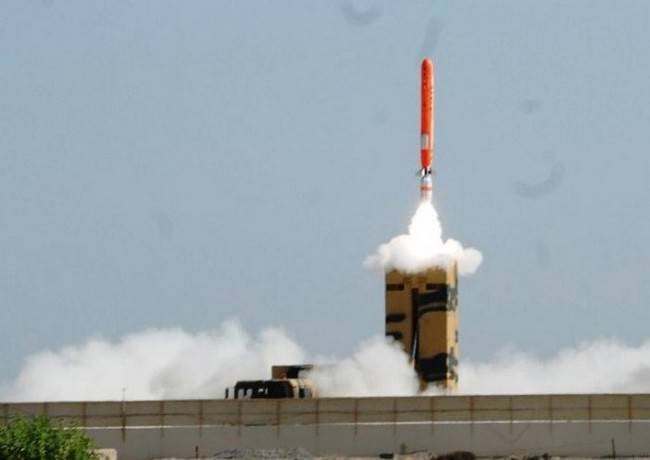
KR land-based "Babur"
Now about cruise missiles. In Pakistan, developed, tested and around XNUMHg. considered to be in service with the KR ground-based "Babur" ("Khatf-2014"). Test it with 7. 2005-12 has been produced, the range, which Pakistan claims for it, is 13-700 km, however, American experts believe that it is smaller - no more than 750km, while Russians estimate the range at 350-450km. There are three modifications of this CR - "Babur-500", "Babur-1" and "Babur-2". The first two modifications are ground-based, on a five-axle self-propelled launcher with 3 missiles (rockets are now launched from closed WPCs, and were previously in half-open launch frames, in early versions of PU launchers). Pakistan claims that the latest-generation CDs are highly accurate, equipped with a GPS / GLONASS receiver, a guidance system using a radar map and a digital image of the target, and can carry both nuclear and conventional warheads. Although whether they actually have SBS, can fit in a fairly compact one-and-a-half KR with warheads of 4kg weight is unknown. Pakistanis are experiencing an anti-shipping version of this CD, but the effectiveness of long-range subsonic anti-ship anti-ship missiles will be a priori low at ranges over 400-300km, the Americans used to burn themselves with the anti-ship version Tomahawk. By the way, "Babur" looks very similar to "Tomahawk", and our X-350, and the Chinese KR DH-55. It is believed that Pakistan created it on the basis of earlier versions obtained from Ukraine X-10. In this case, the “height” of technology can speak about the range, which is several times smaller than even the old version of the original (and X-55MS is almost an order of magnitude).
Launch of the experimental offshore-based offshore submarine platform "Babur-3"
"Babur-3" is so far an experimental version of this CD for launch from a submarine. So far, there have been only two, declared successful, launches in 2016 and 2018, from a submersible platform. Launches from the submarine type "Agosta-90В", on which they want to place this weapon, have not yet been. But before the deployment of this version of "Babur" is still far. As for the ground-based "Baburov", they are believed to be available only at the Acro base near Karachi, where there are about a dozen four-missile SPUs stored in 6 relatively secure shelters-hangars and an underground facility for storing the missiles themselves.
Pakistan has an extensive arsenal of ballistic missiles - in terms of the number of modifications, of course. The fleet of tactical and operational-tactical ballistic missiles is represented by two recently created models. These are the Nasr (Hatf-9) ballistic missile with a range of 60 km, a 1200 kg solid-propellant rocket and a 400 kg carrier, which is a conventional warhead, or, reportedly, with a capacity of less than a kiloton. This weapon is declared by the Pakistanis as a response to the Indian strategy of the Cold Start - a blitzkrieg with the help of tank-mechanized groups deployed in peacetime of up to 8-10 mechanized and tank brigades deep into Pakistani territory, the purpose of which is to reach the densely populated areas of Pakistan and its nuclear facilities, in order to prevent the use of nuclear weapons, not using them, if possible, themselves. A kind of "nuclear mine clearance detachments", only not against mines, but against missiles. The Indians expect that the enemy will not use tactical nuclear weapons on their own soil (why should he not do this - it is not clear). The Pakistanis are planning to use it, but - especially low power. It is believed that there are 24 self-propelled launchers for missiles of this type, 4 missiles per launcher. Another OTR is "Abdali" ("Hatf-2") with a range of 180 km - also solid-fuel with a half-ton warhead and a mass of about 2 tons. It is considered deployed since 2017, although development and testing have been going on intermittently since 1987. There is also an older OTR "Ghaznavi" ("Hatf-3") with a range of 290 km, weighing 6 tons and carrying a 700 kg warhead, conventional or nuclear. It is also a solid-propellant ballistic missile, currently there are 16 known in service with four-axle self-propelled launchers of this complex. Until now, the oldest Pakistani OTR "Hatf-1" is also in service, initially, back in the 80s, the former NUR, and only in the early 2000s became a guided missile with a range of 100 km. But it is now considered exclusively non-nuclear.
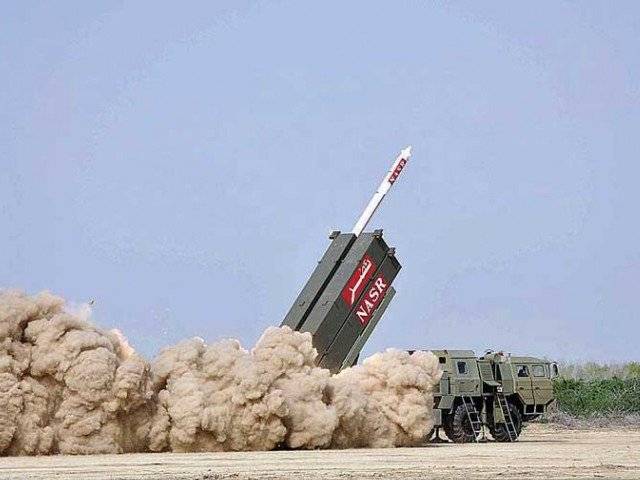
Tactical missile system "Nasr"
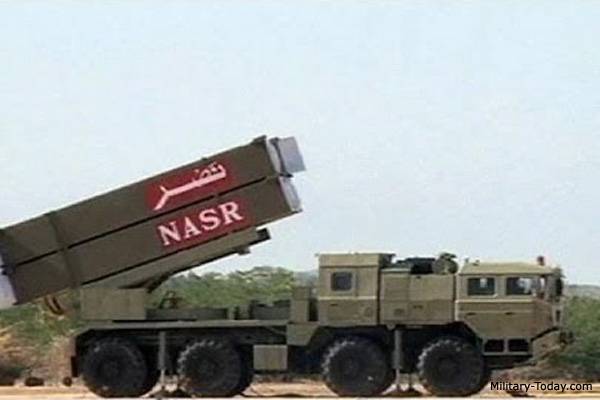
The oldest solid-fuel BR in service, the SBCh carrier, is Шах Shahin-1 ’(“ Hatf-4 ”), 750km range, 9.5 or 10t (in the Шах Shahin-1А version) with the 900km range, which is armed. 2003 Both variants are capable of delivering a conventional high-explosive or cassette warhead to the target, or else SBChs weighing up to 1 tons. There are 16 four-axle SPU in service, practically the same as for the Ghaznavi OTR deployed in three districts of Pakistan. The next "Shahin-2" ("Hatf-6") is already a two-stage solid fuel MRBM with 25 mass and range declared by Pakistan as 2000 km, and Western experts rated as 1500 km. It also carries warheads of a tonne mass, and also detachable - this is implemented on all Shahinakh. About "Shahin-2" Pakistani government and academics also tell tales that his detachable warhead is maneuvering - but you need to treat this as you would Indian boasting on similar topics. As well as the stories about the "surgical precision" of this rocket. But the steer aerodynamic surfaces on a detachable warhead to improve accuracy, in theory, can be implemented. As well as the presence of GOS on some versions of the missiles - the DPRK has similar OTR and BRMD, it is now also in Iran and even tested in combat conditions in Syria. And Pakistanis have close ties with the DPRK, and those with Iran.
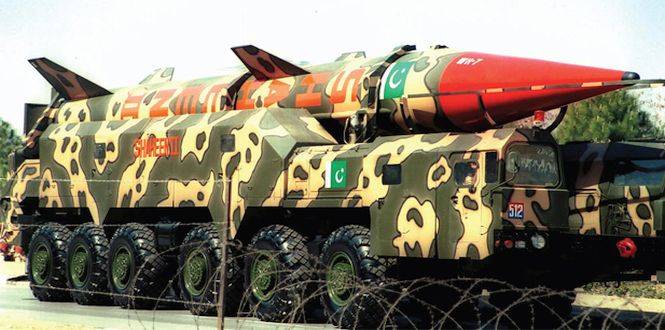
BRSD "Shahin-2"
But maneuvering on the trajectory in order to counteract the missile defense is completely different and the Pakistanis could not have realized this. Just yesterday, Pakistan outsmarted Chinese export projects (BRMD M-9 and OTR M-11, which served as the basis for a number of the systems described above) - and today, is it already putting the maneuvering warheads into service, like Russia? Of course not. The reality in general is often different from the stories of Pakistanis and Indians about their nuclear missiles, and not only them. But today, this MRBD is the most long-range of Pakistan’s weapons. There are about a dozen self-propelled six-axle launchers, the complex is in service with approximately 2014, although this event was promised much earlier.
The pinnacle of Pakistani rocket creativity is the "Shaheen-3" ("Hatf-10"), BRSD range 2750km, also two-stage. But so far this MRBD is on trial, so far there have been only two starts in 2015. and even on paper it was not officially accepted into service. Its radius makes it possible to cover any targets in India from most of Pakistan’s territory, however, Islamabad wanted to have a rocket with such a radius in order to strike also the Nicobar and Andaman islands of India, where, in their opinion, weapons threatening Pakistan could be deployed. True, to hit these islands, rockets must be placed in the most southeastern parts of the country, near the Indian border, which, of course, makes this placement dangerous, including in the light of the Cold Start strategy. On the other hand, “Shaheen-3”, located in the province of Baluchistan (where it is also dangerous to place such weapons, due to difficulties with the local population), is able to reach Israel, which causes concern to the latter. Nevertheless, Pakistan likes to designate itself as the “first Islamic nuclear power”, and if it doesn’t care about Israel now, then what will happen in 10 years? Pakistanis claim that for this BRSD they are developing and sharing warheads with warheads of individual guidance, but this is also, in general, propaganda - there is no miniaturization of nuclear ammunition of the necessary degree, and experience of similar works. If developed, it is very, very long. China will not share technologies with them on this issue - the Chinese also do not have much to boast of, although the first MIRPHINES in China were created, finally. Less than 40 years, as promised to do it.
BRSD "Shahin-3". As we can see, the design is rather primitive, in particular, the aerodynamic control surfaces on the first stage look archaic for a large BR.
All of the above BR were solid fuel. But Pakistanis have fluid systems, of course, without capsulation of tanks and the like, these are very primitive systems that require refueling a few hours before starting, able to spend some time in the filled state, but with extremely low operational efficiency and survival. However, even the solid fuel systems of such a country as China in terms of flexibility, efficiency of application, the sophistication of combat patrols and much more from the specialists of our Strategic Missile Forces serving in Topol, Topol-M or Yars / S rolling performance, cause a smile. What to say about the third-rate nuclear powers. But the enemy is the same.
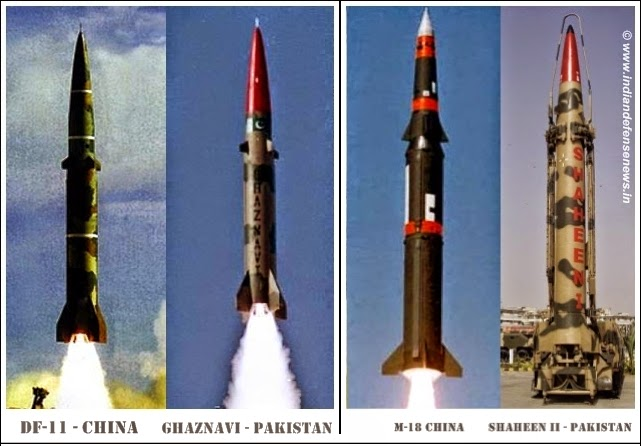
A very unpleasant comparison for Pakistanis of the appearance of their missiles with Chinese products, from their Indian "friends"
Liquid systems are BR "Ghauri-1" ("Hatf-5") weighing 15 tons and a range 1250km and BRSD "Ghauri-2" (weight Hatn-5А), weight 17.8т and range to 1800km. Both types carry a detachable warhead weighing 1200kg. Missiles of this type were among the first to be put into service in Pakistan, and were created explicitly in case there would be problems with a solid fuel program. These missiles were built on the basis of North Korean technology, such as the Rodong-1 BR, which, in general, is a heavily re-sized Soviet Elbrus, the P-17M. In service there is a 24 self-propelled launchers, placed in protected shelters. But not all missiles have nuclear equipment, like other Pakistani systems, there are conventional warheads. Overall, the Pakistani fleet of self-propelled launchers for BR classes from tactical missiles to medium range can be estimated at 90-100 units.
BRSM "Ghauri-2" before the first test
Of course, there is no talk about any means of overcoming missile defense in Pakistan, although it may be something primitive at the latest Shahin, but the Pakistanis have not boasted about it. What is strange, given the above. There is no well-established system of combat patrol areas, with prepared hidden positions for duty, from where it is possible to launch. Of course, they did not hear about the launch from any point of the route either. But the same is true of India - mobile carriers are mainly designed for launch from a site near a protected shelter or tunnel. Although during the crisis period, it is likely that they can be transferred to spare positions in advance. In general, this is a rather flawed approach (as well as a system of protected tunnels, where rockets can be simply buried by the enemy), but given the roughly equal low class of opponents, they will get away with it.
What kind of nuclear charges are on Pakistani carriers? It is believed that Pakistan does not yet produce either tritium-enhanced nuclear charges or thermonuclear charges, and the power of its charges is limited to tens of kilotons. And in general, it mainly produces uranium charges, because it has much more highly enriched uranium than plutonium - 3100kg of highly enriched uranium to the weapons level and 190kg plutonium, of course, is estimated. That's enough for 200-300 nuclear charges. But, of course, they don’t have that much. There are different estimates of Pakistan’s nuclear arsenal - from 60-80 (American intelligence) to 90-100 charges, according to our estimates, and even 130-140 (omnipresent H. Christensen, although it is difficult to believe his estimates - he simply counted all the carriers and counted each charge, although a significant part has the usual warheads). There is no doubt that the Pakistanis continue to increase their arsenal, and there are various estimates of this pace - from 5 units per year to 10-15. And different estimates of the size of the arsenal, which Pakistan wants to achieve in the end as sufficient for itself. This 200 charges, and 220-240, and even more. Although, overestimated estimates are unlikely to have a real basis. Nuclear weapons, even primitive ones, are expensive, and Pakistan is much poorer than extremely poor India, and has a much smaller population. Therefore, it is very likely that Pakistan will overtake the UK in the "official" nuclear five of countries, but neither France, let alone China, will catch up with it and will not try. Yes, and a large arsenal and guard more difficult, especially deployed on media. And the situation in Pakistan is complex, including terrorism, and in Islamabad they understand that the loss of nuclear materials and, especially, charges and their falling into the hands of terrorists is unacceptable, the great nuclear powers and superpowers will not leave it so. Even if the terrorists could hardly even start a primitive charge, this is not a Hollywood film, where such things are very often. In Pakistan or the DPRK, nuclear security is a serious attitude.
It is not very hard to believe that the Pakistanis could sell nuclear weapons to the Saudis, which is a lot of speculation. Despite the close ties and financial support from Riyadh, the Pakistanis understand that the Saudis will not be able to keep such information any longer than the water in the sieve, and this deal will flow to them with tears. And when they need to, the Pakistanis beautifully "rolled" the Saudis, for example, as was the case with the invasion of Yemen. And here the question is much more serious than the permanent perennial coalition getting on different parts of the body from barefoot guys.
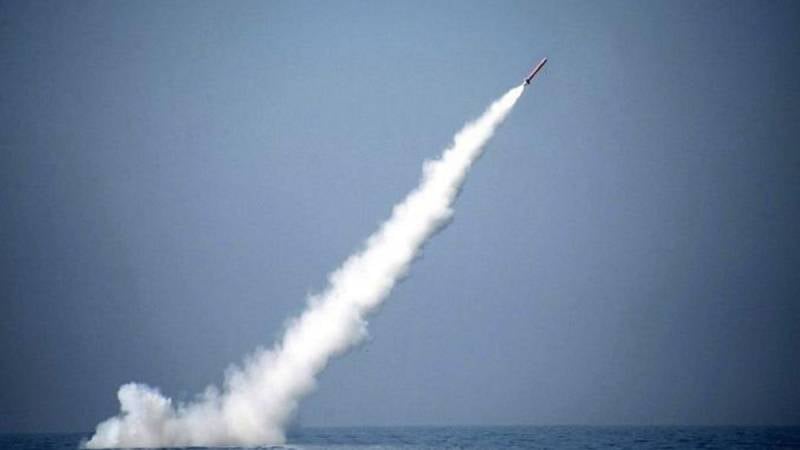
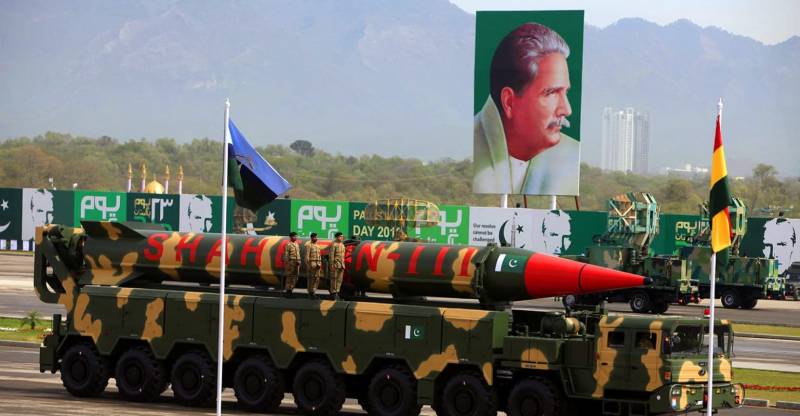
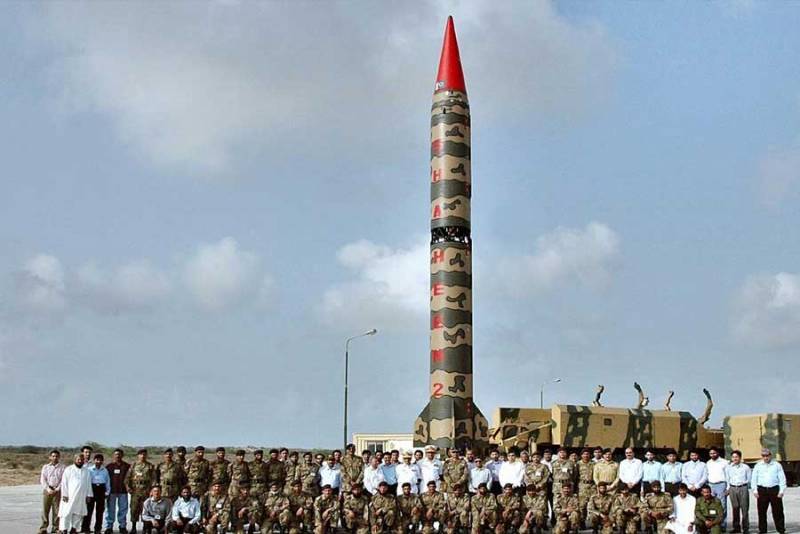
Information